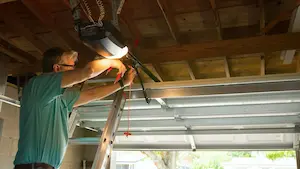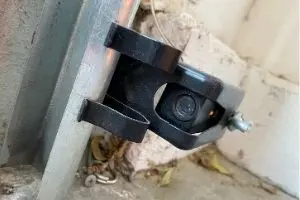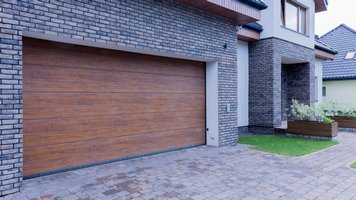14 Reasons Why Your Garage Door Won’t Close & Solutions
This post contains affiliate links.

When you press the button on your remote, expecting the garage door to close smoothly, but it doesn’t, it can be a frustrating experience. Why won’t your garage door won’t close, and what’s the solution?
Common reasons why garage doors may not close include issues with sensors, remote controls, cables, or springs. Solutions often involve removing obstacles or replacing faulty parts. Some work may be best done by a professional.
Understanding why your garage door won’t close can help you quickly identify the solution. Here are some common issues and their fixes.
Why Your Garage Door Won’t Close & Solutions
| Potential Issue | Solution |
| Blocked Sensors | Clean and clear the sensors’ path; remove any obstructions. |
| Misaligned Sensors | Adjust the sensors until their lights stop blinking and glow steadily. |
| Remote Control & Transmitter Issues | Replace batteries and reprogram the remote. |
| Track Misalignment or Obstruction | Clear any debris and adjust the alignment of the tracks. |
| Broken Springs | Replace the springs, preferably by a professional. |
| Opener Malfunctions | Reset the opener’s memory or replace necessary parts. |
| Cable Problems | Inspect and replace frayed or broken cables. |
| Manual Lock Engagement | Disengage the manual lock. |
| Electrical Power Issues | Check power supply and reset circuit breakers or GFCI outlets. |
| Dirty or Misaligned Photo Eye | Clean the photo eyes and ensure they are aligned. |
| Incorrect Limit Settings | Adjust limit settings with a screwdriver until the door closes fully. |
| Worn Out Rollers | Replace damaged rollers to ensure smooth operation. |
| Sticking or Binding Weather Seals | Replace or lubricate the weather seals if necessary. |
| Rust | Clean off surface rust or replace rusted parts. |
Issue #1: Something Is Blocking The Sensors
Safety sensors are crucial for preventing the garage door from closing on a person or object. These sensors are located at the bottom of each side of the door and must have nothing obstructing their line of sight. Common culprits include:
- garden tools,
- toys,
- dirt or even
- vermin like spiders or dead bugs that can accumulate over time.
Solution: Clean and Clear Path
Regularly check and clean the sensors with a soft cloth and mild cleaner. Remove any objects from the sensor’s field of view to ensure they can signal each other without interruption.
This is often all it takes to close your garage door properly. If your garage door refuses to operate as usual, you may have a bigger problem.
Issue #2: Misaligned Sensors
Sensor misalignment is another frequent issue when your garage door refuses to close. These sensors must be exactly aligned to communicate properly. If they are even slightly off, the door will assume an obstruction.
Sensors can be misaligned when they accumulate dirt or may have moved due to impacts. Sometimes, when you push boxes close to the sensor, you may have inadvertently removed the sensor. You may also accidentally kick the sensor.
Solution: Align the Sensors
Loosen the screws that hold the sensors on their mounting brackets and gently adjust them until they are aimed directly at each other. The lights on the sensors typically stop blinking and glow steadily when alignment is correct.
Read all about garage door sensors here.
Issue #3: Remote Control & Transmitter Issues
Remote controls are often the first suspected problem when your automatic garage door doesn’t respond. The issue could range from interference to the remote needing reprogramming.
This could also be as simple as the battery in your remote control running out of juice, causing it to be unable to send a signal to the doors, leading to the issue of your door not closing properly.
Solution: Replace Batteries and Reprogram Remote
Start by replacing the batteries in the remote. If the garage door still doesn’t close, reprogram the remote according to the manufacturer’s instructions, which usually involves pressing and holding the “learn” button on the back of the garage door opener’s motor unit.
When reprogramming your remote, you may want to refer to the user’s guidebook. This is because programming your remote may differ, depending on the maker of your garage door or motor.
Read all about garage door remotes here.
Issue #4: Track Misalignment or Obstruction
A garage door that doesn’t close might be experiencing resistance from misaligned tracks or obstructions, causing the rollers to not operate properly. Tracks must be free of debris and properly aligned for smooth operation.
In many cases, this could result from dirt accumulation on the tracks, although rusting can also happen.
Another possible reason is that your track may have become a place for pests to hang around. This could affect your roller’s movement and cause it to not fully close properly.
Solution: Clear Tracks and Adjust Alignment
Inspect the tracks for any obstructions like stones, dirt, or leaves. Use a level to check the alignment.
If the tracks are out of alignment, loosen the screws that hold the tracks to the garage frame, gently tap the tracks back into the correct position, and tighten the screws.
You also want to spend some time cleaning the tracks and then reapply grease or lubricant spray to lube the tracks. These should help your rollers to move well and remove the issue of your garage door not closing properly.
Issue #5: Broken Springs
Garage doors use heavy springs to facilitate opening and closing. Springs help generate force to help the motor lift the garage door when opening and support the garage door’s weight when closing.
Over time, these springs deteriorate and cannot support your garage door. At times, the garage door springs can break, causing your garage door that won’t close all the way.
Solution: Replace Garage Door Springs
If this is the issue, ensure you have your garage door springs replaced. You can replace your garage door springs, although you want to ensure you implement the process properly. Without the springs, your garage door may slam hard into the ground when closing.
Replacing garage door springs can also be dangerous due to the tension they hold. It’s safest to contact a professional garage door repair service to handle spring replacement.
Issue #6: Garage Door Opener Malfunctions
Sometimes, the garage door opener itself may be the problem, with issues ranging from worn gears to improper limit settings. Your garage door opener motor may also malfunction from age,
Solution: Reset or Replace Parts
Try resetting the garage door opener’s memory and adjusting the limit settings according to the owner’s manual. If the motor runs but the door doesn’t move, the main gear drive might be stripped and needs replacement.
When your garage door motor is very old, you may be unable to find parts for it. In cases like this, consider a new replacement to eliminate the problem of your garage door not closing properly.
Issue #7: Cable Problems
Cables help to steady the garage door as it lifts up or goes down. Cables can also work as emergency support if your garage door springs are not working. They also ensure your garage door closes well and is balanced.
However, like the springs, cables lifting the garage door can wear out or break. This can result in the door hanging unevenly or failing to open or close completely.
Solution: Inspect and Replace Cables
Visually inspect the cables for fraying or breakage. If the cables do not look convincing, it’s time for a replacement. Depending on your competence, replacing your garage door cables can be a simple DIY project.
However, if you are not confident enough, consider calling a garage door repair professional. You may have to work with some highly tensioned cables, which means if you do not know what you are doing, you may cause injury to yourself.
Issue #8 Manual Lock Engagement
An unfortunately common issue, this may be the simplest reason why your garage door won’t close properly. Sometimes, you may have engaged the manual lock on your garage door and forgotten about it.
This could happen during situations such as when you replace part of your garage door systems. When engaged, the manual lock can prevent your garage door from operating normally and prevent it from closing properly.
Solution: Disengage Manual Lock
Check if the manual lock is engaged — often a bar or a knob located in the middle or side of the door. If engaged, simply disengage it to allow the automatic opener to function normally.
For any persistent issues that these steps don’t resolve, it’s advisable to call a reliable garage door repair service. They can thoroughly inspect and resolve complex issues that are not easily diagnosed.
Issue #9: Electrical Power Issues
When your automatic garage door won’t close, the culprit might be a lack of power to the garage door opener. It’s a common issue, and you’re not alone if you’ve pressed the button on your remote and found the door stubbornly staying open.
Solution: Check the Power Supply
The first step is to check whether the garage door opener is actually receiving power. This means inspecting the LED light on the opener—it’s flashes can help you diagnose specific problems.
You should also check your home’s circuit breakers, fuses, and especially the GFCI outlets, which can sometimes trip and cut power to your garage. If these seem fine, but your garage door still won’t close, try resetting these switches.
Often, power surges can trip them, and they just need a quick flip to restore order.
If these steps don’t fix your garage door, it could be time to call a reliable garage door repair service. Sometimes, issues like a blown motherboard in the opener or a faulty wiring connection are to blame, and these require professional attention.
Issue #10: Photo Eye is Dirty or Misaligned:
A photo eye is a critical safety feature on your automatic garage door, located near the floor on either side of the door.
These sensors send signals across the doorway to ensure nothing is blocking the garage door’s path before it closes. If dirt or debris obscures the lens, or if the sensors become misaligned, the garage door won’t close fully, often reversing open as a safety precaution.
Solution: Clean & Check Photo Eye
If you notice your garage door isn’t closing, a simple check of the photo eyes could be the answer you’re looking for. Start by gently cleaning the lenses with a soft cloth and a mild cleaner. Avoid harsh chemicals that could damage the sensors.
Next, make sure they are properly aligned. Misalignment can occur if a sensor is accidentally bumped or knocked. You’ll know everything is aligned when both sensor lights are solid, with no flickering.
Issue #11: Limit Settings are Incorrect
The limit settings on your automatic garage door tell it how far to open or close before stopping.
If these settings are off, you might find your garage door won’t close all the way or it reverses before hitting the ground. It’s one of the most common reasons why your garage door isn’t closing properly.
Solution: Check & Adjust Limit Settings
To solve this, you’ll need to adjust these settings, which is usually done with a screwdriver and following the manufacturer’s instructions. On most garage door openers, you’ll find ‘up’ and ‘down’ limit adjustment screws.
If your door doesn’t close fully, turn the ‘down’ screw clockwise in small increments. Test the door after each adjustment. It’s a bit of trial and error, but it’s necessary to get the settings just right.

Sometimes, even small adjustments can make a big difference. If you adjust too much, the door might try to close too far and strain against the ground, which can be just as problematic.
Issue #12: Worn Out Rollers
Garage door rollers are essential for the smooth and efficient operation of your automatic garage door. These rollers help the door to glide along the tracks when it opens or closes.
If they wear out or break, you might find your garage door won’t close all the way, or it might veer off track, preventing proper closure.
Solution: Check And Replace Rollers
If you notice your garage door isn’t closing smoothly, check the rollers. You might see signs of wear, like cracks, flat spots, or even rust. To fix this, you’ll need to replace the damaged rollers. This usually involves:
- removing the brackets holding the rollers,
- sliding them out, and then,
- installing the new ones.
Make sure to choose rollers that match the specifications of your garage door system to ensure they can handle the weight and frequency of use.
Replacing rollers can be tricky and requires precision to ensure the door is properly aligned on the tracks. If you’re not comfortable doing it yourself, it’s wise to call a professional garage door repair service.
They can handle the replacement quickly and ensure your door operates smoothly, so you don’t have to worry about further damage or safety issues.
Issue #13: Weather Seals Sticking or Binding
The weather seal on your garage door plays a crucial role in keeping the elements out and maintaining the efficiency of your home’s heating and cooling.
However, a sticking or binding weather seal might prevent your garage door from closing properly.
Over time, weather seals can become brittle, crack, or even stick to the door frame, especially in cold weather, which prevents the door from closing all the way.

Solution: Check & Replace Weather Seals
If you notice your garage door won’t close fully, check the weather seal along the bottom and the frame. Look for visible signs of wear or damage, such as cracks or areas where the seal might be sticking.
Replacing a damaged or worn weather seal is straightforward: you can usually pull the old one out of its track and press a new one into place. Ensure you choose a seal that matches your garage door model for the best fit and protection.
Sometimes, lubricating the seal can also help prevent sticking without a full replacement. However, if the issue persists, it might be wise to just replace the whole seal.
Issue #14: Rust
Rust is more than just a cosmetic issue for garage doors; it can severely impact their functionality. When metal components of your garage door, such as springs, hinges, or rollers, start to rust, they deteriorate and become weak.
This can lead to your garage door not closing properly or even becoming stuck. Rust can cause parts to seize up, preventing smooth operation and potentially blocking the garage door’s path.
Solution: Check & Replace Rusted Parts
If you find rust while inspecting your garage door, it’s important to address it promptly. Start by cleaning off surface rust with a wire brush. This might be enough for parts that aren’t critically damaged.
However, if the rust is extensive, you’ll likely need to replace the affected components. Springs, cables, and rollers are usually under high tension and should be replaced by a professional garage door repair service to ensure safety and proper installation.
Regular maintenance can prevent rust from becoming a problem. Apply lubricant to moving parts periodically, and check for signs of wear or damage.
Fix A Garage Door That Won’t Open
Troubleshooting your garage door when it won’t close involves addressing common issues like sensor blockages or misaligned tracks. Regular maintenance and timely interventions can prevent most problems.
However, consulting a professional for complex issues like broken springs or opener malfunctions is prudent. Keeping your garage door in optimal condition ensures safety and convenience, preventing malfunctions and costly repairs.






